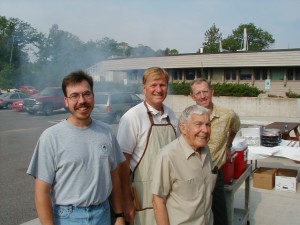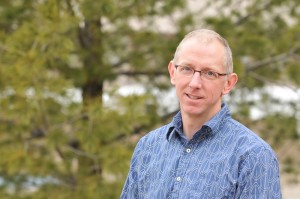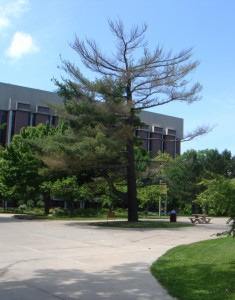| by Marcia Goodrich, senior writer
“Gentleman” Gene Hesterberg, 92, who booted more than one errant forestry student back onto the road to graduation and found jobs for countless others, died Sunday, Sept. 26, at the Delaware House of PortagePointe, where he had lived for the past two years. Hesterberg, of Hancock, came to Michigan Tech’s forestry department in 1948 and rose through the ranks of the faculty. He was named department head in 1962 and held that position until his retirement in 1981.  “He really was inspirational to a lot of students,” said Dean Peg Gale (SFRES). “When I talk with alumni, they tell me about Gene and the influence he had on them, not only while they were at Tech but also in their careers.” Karin Van Dyke ’78 was among them. “Gene was a big help to me and hundreds of other forestry students. He was responsible for my first job,” she said. “And he was very approachable. He had an open-door policy before open-door policies were invented. Plus, how could you not like a guy who called you ‘Pard’?” It’s even conceivable that Michigan Tech might have a different president had it not been for Hesterberg’s well-timed intervention in the career of a certain forestry undergraduate. “Gene had a gift for remembering names, and that worked really well until the student population in forestry got up to about 700,” said President Glenn Mroz. “Then it became an impossible task for even the most gifted mind. So everybody became Pard. I was, everybody was.” Hesterberg went hunting and fishing with students, as well as teaching and advising them. “As a result, he had a familiarity with students that was almost unheard of,” Mroz said. “Gene never hesitated to give anybody the Dutch uncle talk when they really needed it. As you might have suspected, I was one of those people. I had dropped out of school at one point, and Gene readmitted me. It was a couple years later that he urged me to go for a doctorate.” Hesterberg also played a key role in building the foundation of the School’s research program, Mroz said. “He was involved in research himself, and he knew that graduate studies would play a big role. So, he hired people like Marty Jurgensen and Norm Sloan to position the School for the future.” Hesterberg received the Clair Donovan Award in 1975 for his efforts on behalf of a student football player who had been injured and needed to use a wheelchair. “He put together a curriculum for him so he could finish school,” Mroz said. Among his other honors, Hesterberg received Tech’s Distinguished Teacher Award in 1980, was named a fellow in the Society of American Foresters, and was inducted into the Michigan Forestry Hall of Fame. In 1962, the Michigan Academy of Science, Arts and Letters awarded him its Academy Citation for outstanding contributions in conservation, research and teaching. He established the Gene and Margaret Hesterberg Scholarship in 1979, named for himself and his late wife, and provided a generous donation to the School to support the expansion of the U. J. Noblet Forestry Building. Hesterberg Hall is named in his honor. He was born Aug. 30, 1918, in Cincinnati and served in the army during World War II. He earned a BS from Purdue University and MS and PhD degrees from the University of Michigan, all in forestry, and was a biologist with the Michigan Department of Conservation before coming to Michigan Tech. Hesterberg was active in the community, serving on the Lake Linden Board of Education and on the Keweenaw Memorial Hospital Board. He owned a sawmill and Silver Forests, a timberland operation of several thousand acres. “He hired me in 1975, and I’ve been here ever since,” said Mary Jurgensen, the School’s scheduling counselor. “Gene was like a father to all of us. He treated us all like family, and he was so great with students, a one-man career center. He found jobs for everybody.” “People used to call him ‘Gentleman Gene,'” she said. “And he was a true gentleman. He was always thinking about the School, the students and the faculty, working hard for them. He was a great guy.” Van Dyke agreed. “He was an awesome guy,” she said. “The world has lost a great forester and a great friend.” Hesterberg is survived by his wife, Judith, of Hancock; sons William (Sharon) of Rosendale, Wis., and John (Debby) of Port Huron; and grandchildren Brian, Christopher and Katie. Services were held Tuesday at the Old Apostolic Lutheran Church in Hancock. Burial was in the Oskar Cemetery. Memorials may be given to the Alzheimer’s Association or to the Activities Fund at PortagePointe. Memorial Chapel Funeral Home in Hancock assisted with arrangements. To view the obituary or send condolences, visit the Memorial Chapel website. |
PlanetGreen.com featured an essay published by Assistant Professor John Vucetich and his colleague at Michigan State, Michael Nelson, as one of its five tips for actio n on Earth Day. See tip four at Tips .
n on Earth Day. See tip four at Tips .
| by Jennifer Donovan, director of public relations
Frank Best, a 1975 forestry alumnus and middle-school science teacher at Menominee Catholic Central, is bringing two groups of sixth, seventh and eighth grade students to Michigan Tech for a hands-on science experience on Monday and Tuesday, Sept. 13-14. On Monday, they will take a learning cruise of Portage and Torch Lake and Lake Superior on the Research Vessel Agassiz. Each group will spend two hours on Tuesday in the lab, where the students will dissect lake trout stomachs and examine the water samples they gathered under a high powered microscope. They will use a guidebook to identify the algae in their water sample. They will also study the organisms they collect from bottom samples. Using all this data, they will construct a food web of the lake. This is the fifth year that Best has brought his students to Michigan Tech. After riding on the Agassiz himself during a summer course he took at Tech on “Using Navigation to Teach Math,” he decided it would be an ideal hands-on learning experience for his students. “One of my main goals as a science and math teacher is to expose students who use math and science in their jobs,” said Best. “I want students to understand that math and science are ways of looking at our world, not just classes that you have to take in school.” The teacher said his students gain a great deal of knowledge about the Lake Superior ecosystem from their time on the Agassiz. “They also get to experience so much more than I can show them in the classroom,” he added. “They get to use state-of-the-art equipment that we can not afford at our small school.” The Agassiz will make several stops to enable the students to measure the depth, temperature and dissolved oxygen of the lakes at different depths. They will also sample the mud on the bottom of the lakes to find out what might be living down there. They will use a plankton net to capture some of the members of the plankton community. While the students are at Tech, they will also see a MSE demonstration and visit Nara Nature Park as part of a SFRES program. The Menominee students will stay at St. Anne’s church in Chassell and St. Albert the Great church in Houghton. |
 Professor David Flaspohler has received $72,512 from the National Science Foundation for the first year of a potential five-year, $349,488-project, “Interactive effects of predation and ecosystem size on arthropod food webs in Hawaiian forests fragmented by lava flows.”
Professor David Flaspohler has received $72,512 from the National Science Foundation for the first year of a potential five-year, $349,488-project, “Interactive effects of predation and ecosystem size on arthropod food webs in Hawaiian forests fragmented by lava flows.”

When the Leaning Tree, also called the EERC Tree, was cut down in August, the question was: which was older, the campus or the tree? The campus dates back to 1887, when Jay Hubbell donated land for the Michigan College of Mines; it turns out the tree is older by sixteen years, says Mike Hyslop, GIS analyst and a doctoral student in forest science, SFRES.
Recall that Facilities cut a slab, called a “cookie,” for Hyslop, so he could determine how old the tree was by counting the rings. Each annual ring is composed of two parts–“early” and “late” wood–with different color and structural characteristics.
By Hyslop’s count, it is likely that the Leaning Tree, a white pine, took root–Hyslop says “was established”–in 1871.
This is dendrochronology: the dating of wood. Trees add both height and diameter annually. The radial growth exhibits patterns that vary primarily according to precipitation and temperature, but also light availability and disturbance.
Typically, warm temperatures and plentiful precipitation produce wider rings; and cooler, drier conditions produce narrower rings. Missing rings occur in “high ecological stress” years, when the tree does not have the resources to put on radial growth.
To age the Leaning Tree, Hyslop sanded the slab because chain saw blades produce a fairly rough surface, and the rings are difficult to discern, especially when there are several small-growth years in a row and the rings are closely spaced.
To date the tree back to 1871, Hyslop counted the rings twice by hand, under magnification, and came up with the same result. He will do some additional sanding and recheck his findings.
“I am reasonably confident,” he says, “that the 139 years is correct, but there are a few areas of densely-packed rings that bear closer scrutiny.”
The tree, then, was witness to the entire history of the institution to date. Hubbell donated the land, the site for the first campus building, Hubbell Hall, on Aug. 26, 1887. The local newspaper, in a modest story, announced the donation five days later, on Sept. 1, under a small headline reading “Our Mining School.” It read, in part, “This site seems to us to be in every way adapted for the Mining School. The drainage is perfect, it will be in a pleasant neighborhood, with fine views up and down the lake, and of the opposite shore. There are numerous other sites in town which could have been obtained, but it seems to us that the committee [Board of Control], in deciding to accept the one presented by Mr. Hubbell, have acted wisely, and that the people will be fully satisfied.”
The tree outlived the Hubbell building, which was demolished in 1970, by 40 years.
Another white pine will be planted in its space. The history it will witness? Only time will tell